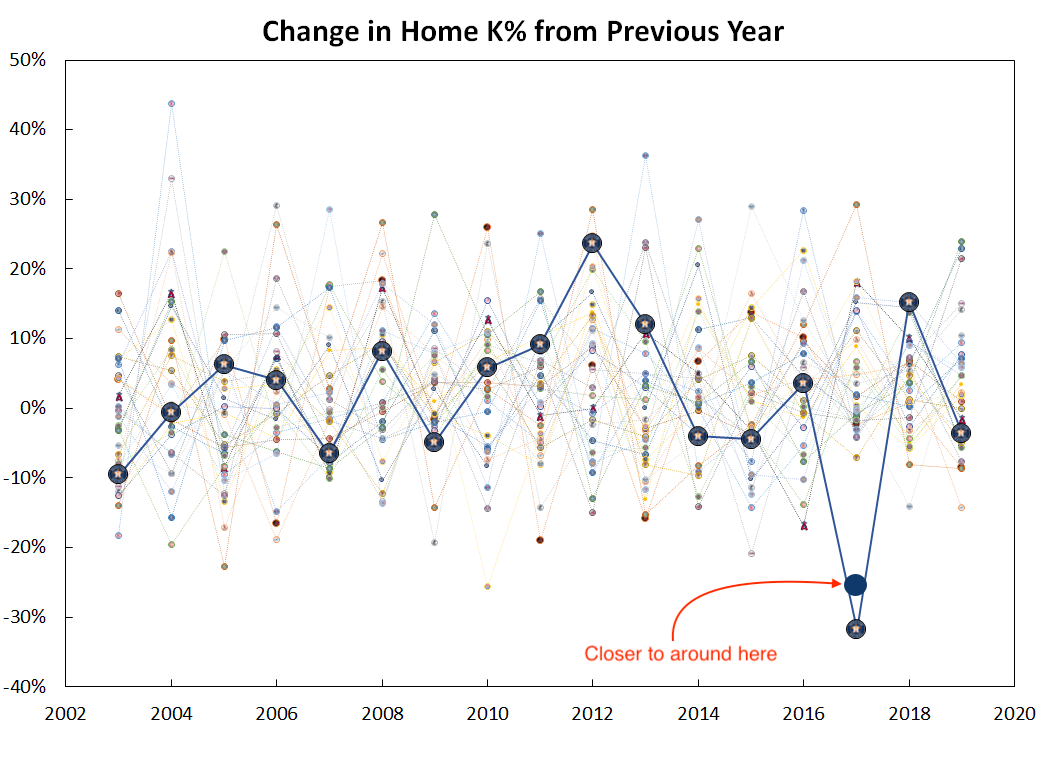2023 Reading List
Books I read in 2023
This week, major news broke about the Astros stealing signs at home in 2017, and relaying this information to their players via hitting a trash can in their dugout. There’s been a lot of mixed reporting on how much this actually affected their play. Some have argued there wasn’t significant impact, citing that they performed comparably, or even better, on the road. Others, such as this study by a Reddit user claim that it dramatically helped them, referencing their year-to-year K%.

The oversight in this study is that the personnel changed dramatically between 2016 and 2017, getting rid of players like Castro, Rasmus, Valbuena, and Gomez, while acquiring players like Beltran and Reddick. This is something that I wanted to investigate further, trying to remove the influence of the changing players.
I decided to take a look into just the players that had PAs in both 2016 and 2017, giving continuity over the years, and providing samples in both a time before and after the trash can sign stealing began. Ultimately this list came to the following players:
For these players, their K% does still drop significantly, from 22.2 to 16.5%. Ultimately this is a 5.7 K% drop year-over-year, and evaluating against the plot above, it’s a 25.7% change. Getting back to the question of, “did sign stealing actually help them all that much,” comparing to the presented plot, this would certainly still be an extreme value, so naively it seems like it most probably did help. However, I don’t think you can entirely rule out the null hypothesis, the author cites that the Rangers change from 2009 to 2010 was 25.6%, nearly identical to the change the Astros experienced. Crudely adjusting that plot:

The full work can be found in this jupyter notebook.
One factor that isn’t accounted for in this quick check the fact that players do get better, especially when the team is rather young. Bregman, for example, had his rookie season in 2016 with 217 PAs. In his sophomore season, he dropped his K% from 24.0% to 15.5%, and likely some portion of that is just from additional MLB experience.
Books I read in 2023
Who will win this year’s cup?
Books I read in 2022
Just how lucky have the 18-3 Bruins gotten?
Interoperability is the name of the game
Books I read in 2021
I got a job!
Books I read in 2020
Revisiting some old work, and handling some heteroscadasticity
Using a Bayesian GLM in order to see if a lack of fans translates to a lack of home-field advantage
An analytical solution plus some plots in R (yes, you read that right, R)
okay… I made a small mistake
Creating a practical application for the hit classifier (along with some reflections on the model development)
Diving into resampling to sort out a very imbalanced class problem
Or, ‘how I learned the word pneumonoultramicroscopicsilicovolcanoconiosis’
Amping up the hit outcome model with feature engineering and hyperparameter optimization
Can we classify the outcome of a baseball hit based on the hit kinematics?
Updates on my PhD dissertation progress and defense
My bread baking adventures and favorite recipes
A summary of my experience applying to work in MLB Front Offices over the 2019-2020 offseason
Books I read in 2019
Busting out the trusty random number generator
Perhaps we’re being a bit hyperbolic
Revisiting more fake-baseball for 538
A deep-dive into Lance Lynn’s recent dominance
Fresh-off-the-press Higgs results!
How do theoretical players stack up against Joe Dimaggio?
I went to Pittsburgh to talk Higgs
If baseball isn’t random enough, let’s make it into a dice game
Random one-off visualizations from 2019
Books I read in 2018
Or: how to summarize a PhD’s worth of work in 8 minutes
Double the Higgs, double the fun!
A data-driven summary of the 2018 Reddit /r/Baseball Trade Deadline Game
A 2017 player analysis of Tommy Pham